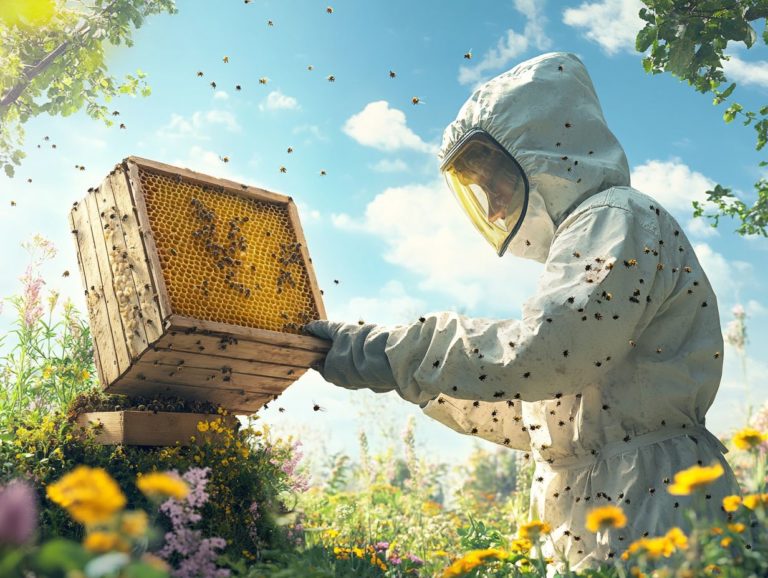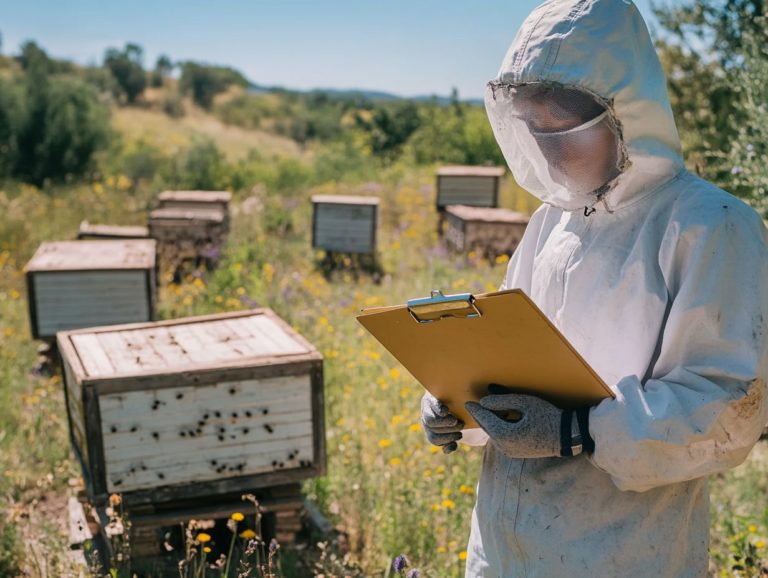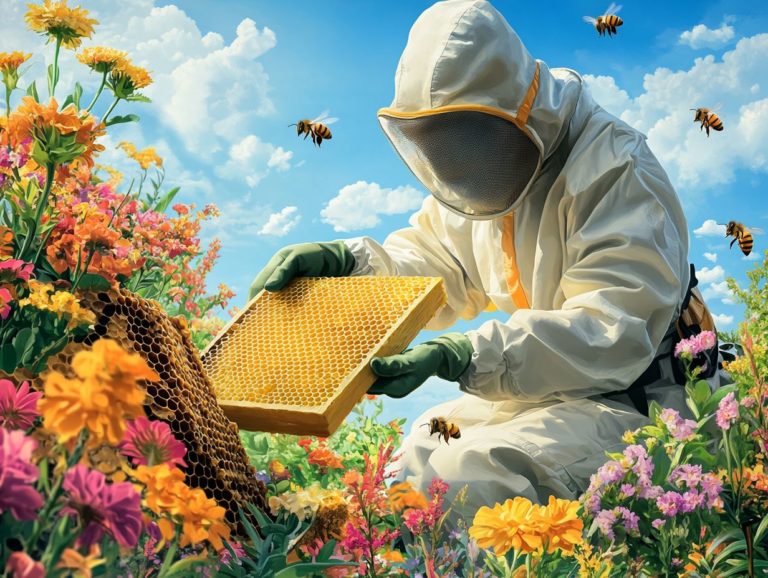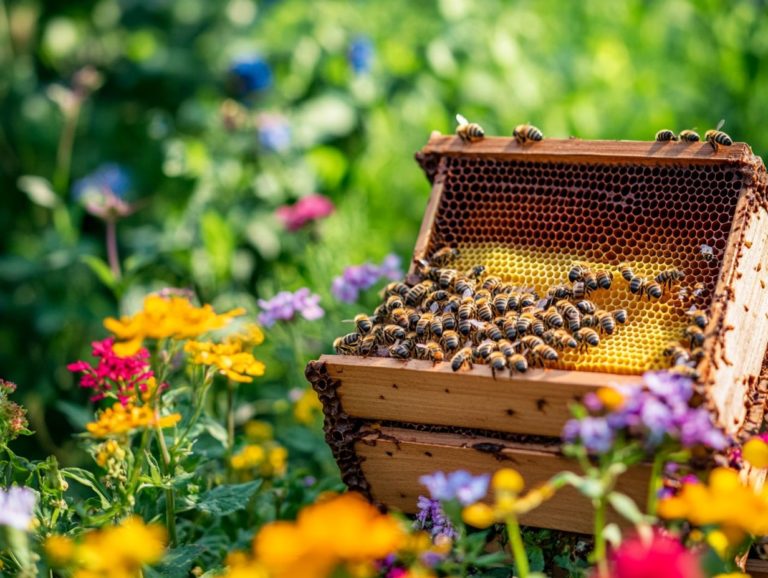The Importance of Hive Records
Maintaining comprehensive hive records is crucial for you as a beekeeper, especially if your goal is to ensure the health and productivity of your bee colonies.
Whether it s monitoring hive health, evaluating queen performance, tracking honey production, or identifying potential pests and diseases, effective record-keeping is integral to successful beekeeping. It helps maintain good records and ensures that any issues can be addressed promptly.
This article delves into the importance of hive records, highlighting the vital information you should include and offering practical tips for keeping accurate logs.
Explore how organized data can elevate your beekeeping practices and lead to thriving hives and healthy colony conditions.
Contents
- Key Takeaways:
- Discover Why Hive Records Matter for Your Beekeeping Success!
- What Information Should Be Included in Hive Records?
- How to Keep Accurate Hive Records?
- Frequently Asked Questions
- What are beehive records and why are they important?
- What types of information are typically included in beehive records?
- How can beehive records help beekeepers maintain healthy hives?
- Are there any specific methods or tools used to keep beehive records?
- Can beehive records also be used for research purposes?
- What are some potential consequences of not keeping beehive records?
Key Takeaways:
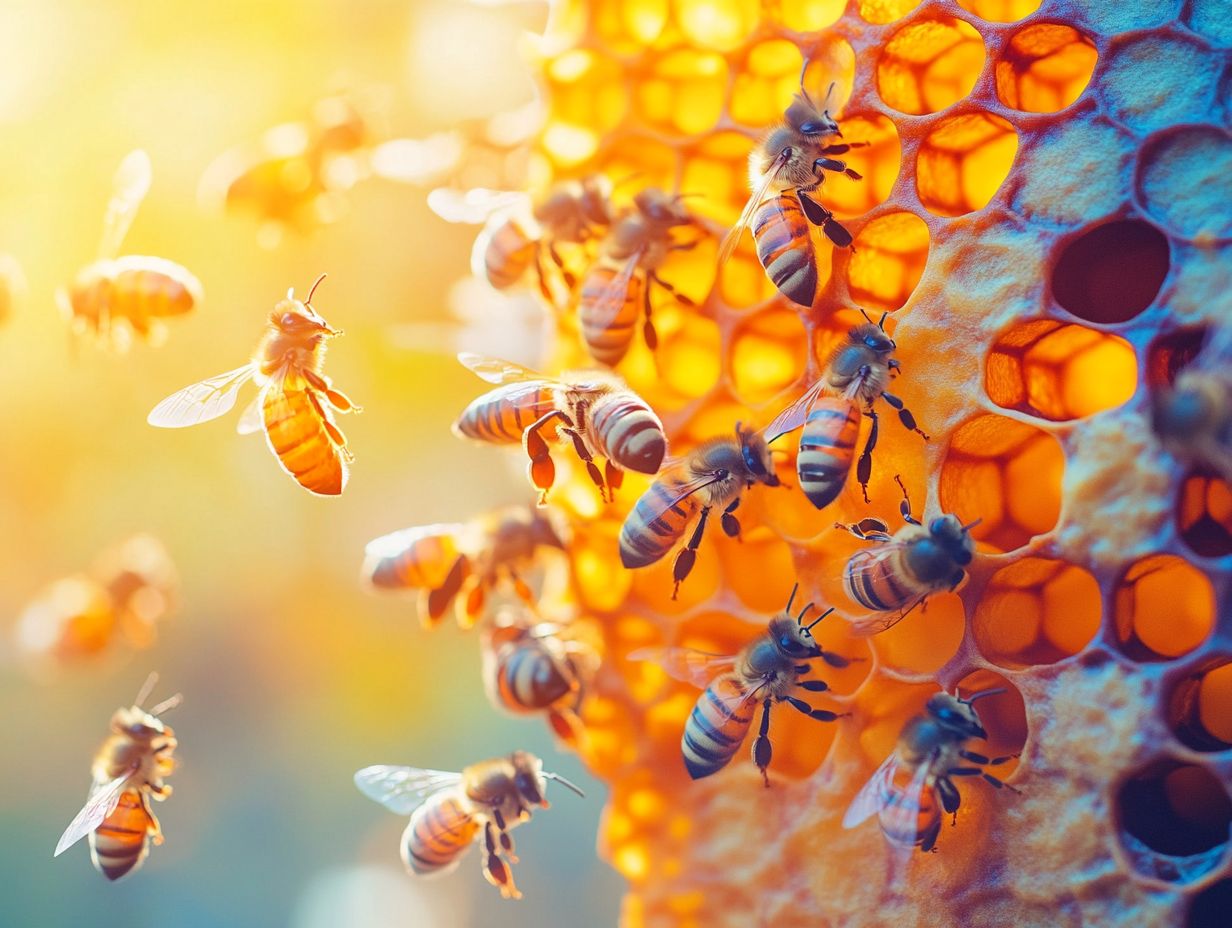
- Monitoring hive health is crucial for the overall success of a bee colony. Regularly keeping accurate hive records, including hive inspection logs, helps identify potential issues and allows for timely actions to maintain hive health.
- Hive records provide valuable information about the performance of the queen bee. By tracking her laying patterns and behavior in a beekeeping journal, you can ensure the quality and productivity of the colony.
- Tracking honey production through hive records is essential for evaluating the success of your hive management practices. It also aids in predicting future harvests, planning for the sale of honey, and keeping track of hive updates.
Discover Why Hive Records Matter for Your Beekeeping Success!
Hive records, including hive identification and hive characteristics, are key to your beekeeping success.
Effective management of your colonies hinges on maintaining precise beekeeping records. These records help monitor hive conditions and track the status of your colonies, which in turn informs decisions that enhance honey production and overall colony vitality.
Additionally, you can streamline your record-keeping by using digital tools such as hive tracking software. This elevates the quality of your hive inspections and helps you apply swarm prevention strategies based on your records.
1. Monitoring Hive Health
Monitoring hive health is a vital component of effective hive management. It enables you to observe the conditions within your colonies and identify potential issues before they escalate into serious problems.
Regular inspections are essential for assessing key indicators such as brood patterns, queen health, and the presence of pests or diseases. By diligently checking each aspect, you can catch signs of stress or illness, including honey bee diseases, early on, ensuring the longevity and productivity of your colonies.
During these inspections, it’s important to record specific data, including the number of capped and uncapped brood cells, the presence of the queen, and any signs of disease such as foul brood or Varroa mites. Additionally, noting the overall population dynamics and colony behavior, including foraging behavior, can provide invaluable insights into the hive’s well-being.
Keeping detailed records is not just important; it s a game changer for your hive, helping you maintain hive health and enabling informed management decisions.
2. Identifying Queen Performance
Identifying queen performance is crucial for maintaining a thriving beehive. A healthy queen bee is the cornerstone of proper brood development and overall colony productivity.
To effectively assess the queen’s health, you should conduct regular hive inspections. Pay close attention to key indicators such as the presence of eggs, larvae, and healthy worker bees. Signs of a queenless colony like increased aggression among workers or a notable lack of brood can be concerning for the overall health of the hive. If you spot queen cells, it s a clear sign that the bees are making a bid to replace a failing queen.
Poor queen performance can throw the entire colony’s dynamics into disarray, leading to decreased honey production, a declining population, and ultimately, the collapse of the hive. Act quickly to recognize these signs so you can take the necessary corrective actions to ensure the survival and productivity of your colony.
3. Tracking Honey Production
Tracking honey production is crucial for beekeepers. It ensures that hive boxes are managed properly, helping you assess the success of your colonies and make informed decisions about honey supers and hive management.
By keeping meticulous hive logs and closely monitoring nectar flows the amount of nectar collected by bees from flowers you gain invaluable insights into your bees behavior and productivity.
This practice requires you to record not just the weight of honey supers and the number of filled frames but also pay attention to environmental factors like blooming patterns, weather conditions, and forage availability.
Consistent and thorough data entry can profoundly influence your strategic decisions. This allows you to make timely interventions, adjust your hive management practices, and refine your harvesting techniques.
Ultimately, these diligent practices ensure that your colonies remain healthy and productive, leading to a more rewarding yield at the end of each season.
4. Detecting Pests and Diseases
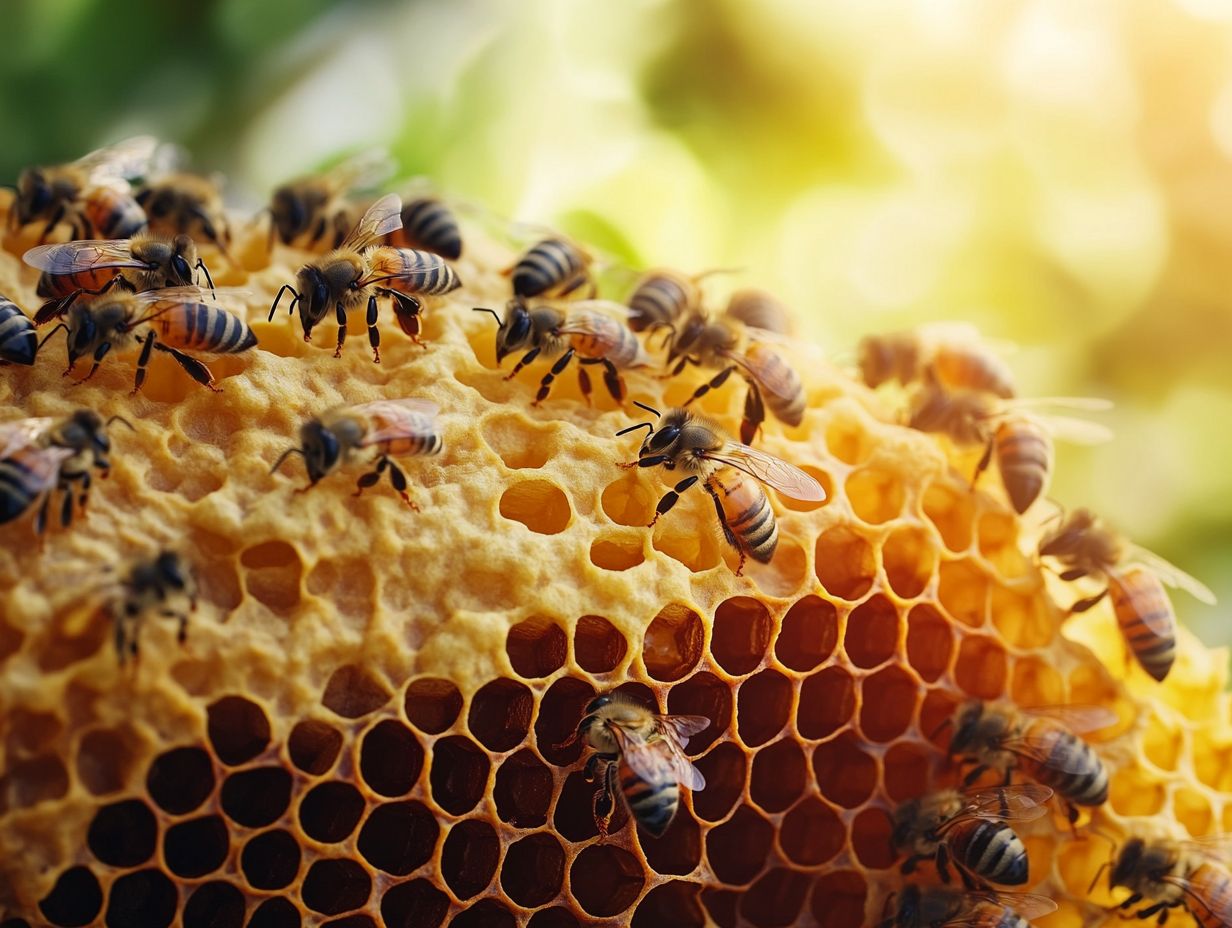
Spotting pests and diseases in your beehives is critical for keeping your colony thriving! Act quickly, or you risk significant losses.
Monitoring for common threats is essential; nuisances like chalk brood and mite infestations can wreak havoc on your bee populations, resulting in reduced honey production and weakened bees.
Stay vigilant during your regular inspections. These proactive measures help you identify symptoms early and facilitate effective intervention strategies and hive management.
By implementing a comprehensive inspection plan, you equip yourself with the knowledge to recognize these issues before they escalate. This ultimately ensures the vitality and productivity of your entire hive.
What Information Should Be Included in Hive Records?
To maintain an effective hive record, ensure it is comprehensive, including vital details such as hive inspections, queen status, honey production levels, and pest and disease management practices. Keeping detailed records is crucial for a healthy colony.
1. Hive Inspections
Regular hive inspections are essential for effective beekeeping and good record keeping. They allow you to assess colony conditions, brood patterns, and overall hive health through careful entries in your hive inspection log.
By conducting these inspections routinely, you gain critical insights into the status of your colonies, enabling you to intervene promptly if any issues arise. During each inspection, watch for signs of diseases, pests, and adequate food stores, and confirm the queen’s presence and her laying patterns.
Taking accurate bee notes during these inspections is vital; they serve as a reference guide for future evaluations. This helps you track trends and make informed management decisions.
Utilizing checklists or templates simplifies this process, ensuring that no essential information slips through the cracks. Ultimately, this enhances the care you provide to your hives.
2. Queen Status
Documenting the queen’s status is essential for beekeepers, as it directly influences brood development and the overall productivity of your hive.
During regular inspections, focus not only on the queen’s presence but also on her egg-laying behavior and overall health. Gauge the queen’s vitality by observing her physical condition size, color, and movement patterns within the hive are telling signs.
Keeping an eye on the presence of queen cells is crucial; these indicate the colony’s intention to supersede the current queen or prepare for swarming. A colony without a queen faces significant challenges, leading to disorganized foraging and decreased brood rearing, which ultimately affects your hive’s productivity.
To navigate these dynamics effectively, maintain detailed records of your observations regarding the queen. Note any changes in her behavior, cell development, and overall hive conditions. This proactive approach ensures the health of your colony stays on track.
3. Honey Production
Monitoring honey production, including beeswax and nectar collection, is essential for you as a beekeeper. It allows you to evaluate the effectiveness of your strategies for taking care of your hives to maximize honey production and make informed decisions about honey supers and harvesting.
By closely tracking honey yields and hive characteristics across different seasons, you can uncover patterns influenced by factors like weather, flowering periods, and the overall health of your hives. Paying attention to the timing and intensity of nectar flows is crucial; it gives you insight into when your bees are most active and when you can expect peak production.
The data you gather becomes invaluable for forecasting future yields and planning accordingly. Ensuring that your hives are well-stocked with resources like nectar and pollen is vital. You should use hive logs to document honey production such as daily measurements and observations about nectar availability or hive conditions. This creates a comprehensive overview that enhances your honey production tracking.
This documentation not only serves as a historical record but also acts as a predictive tool for optimizing future harvesting efforts.
4. Pest and Disease Management

Effective pest and disease management is vital for the longevity of your bee colonies. As a beekeeper, you need to maintain careful records of the number of tiny pests that can harm bees and observations of honey bee diseases, such as chalk brood.
To ensure the health of your hives, you should conduct regular inspections every few weeks. During these inspections, meticulously examine brood patterns, observe the overall behavior of the bees, check for queen cells, and look for any visible signs of distress.
Adopting a structured method for recording your inspection data is crucial. Whether you opt for a standardized checklist, a beekeeping journal, or a digital app, having a system in place will help you track trends and make informed decisions over time.
You must act quickly on any findings after each inspection. This might involve treating infested hives with appropriate interventions or implementing preventive measures to reduce the risk of disease spread. Taking this proactive approach can significantly enhance the resilience of your colonies and improve overall colony health, ensuring they thrive for the long haul.
How to Keep Accurate Hive Records?
Keeping precise hive records is the key to your success as a beekeeper! You can achieve this by utilizing standardized templates, exploring online hive management systems like Hive Tracks or BeeBase, or even employing digital voice recorders for swift data entry.
1. Use a Standardized Template
Utilizing a standardized template for your hive records can significantly enhance the accuracy and efficiency of your record-keeping. This ensures that all key data is captured consistently in your beekeeper s log.
This approach simplifies the documentation of crucial information, such as hive inspections, treatment applications, and honey yields. It also ensures that every detail ranging from weather conditions to bee behavior and colony conditions is meticulously noted.
By streamlining your documentation process, you can adhere to a systematic inspection plan, making it easier to identify trends and patterns over time. A uniform method of data collection allows for better comparisons between different hives, leading to healthier colonies and optimized production.
Ultimately, maintaining consistency in your hive records provides invaluable insights that can elevate your overall beekeeping practices.
2. Record Data Regularly
Regularly recording data is essential for you to maintain up-to-date hive records. This enables you to identify trends and changes in colony behavior and hive status over time.
Establishing a consistent routine for data input can significantly elevate your overall management of bee colonies. By designating specific times for inspections and logging your observations into your hive inspection log, you ensure that no detail slips through the cracks.
To keep yourself on track with logging hive inspections, consider setting reminders on your mobile device or weaving this task into your daily schedule. Over time, this consistency will deepen your understanding of the colony’s health and productivity.
Well-documented records make it easier to analyze patterns and spot potential issues in colony conditions. Ultimately, the more systematic and organized your approach, the better equipped you’ll be to tackle challenges and maintain thriving hives in your bee yard. This highlights the importance of maintaining hive records.
3. Utilize Technology
Utilizing technology in your beekeeping practice, such as hive tracking software and digital voice recorders, makes managing your hives easier and more efficient. Tools like Hive Tracks and BeeBase are especially helpful.
These innovative tools not only streamline the documentation of hive conditions and activities, but they also enable you to analyze trends over time. By embracing an online hive management system, you gain real-time access to your data from anywhere, enabling timely and well-considered choices.
For instance, Hive Tracks offers integrated features that help you keep track of all your hive updates and activities. In contrast to traditional methods, which often rely on cumbersome paper logs and tedious manual entry, digital solutions greatly reduce errors and promote collaboration among team members.
Cloud-based platforms can even provide reminders for routine tasks and offer valuable insights into hive health. Ultimately, this leads to more productive and sustainable bee farms in your bee yard.
4. Review and Analyze Data
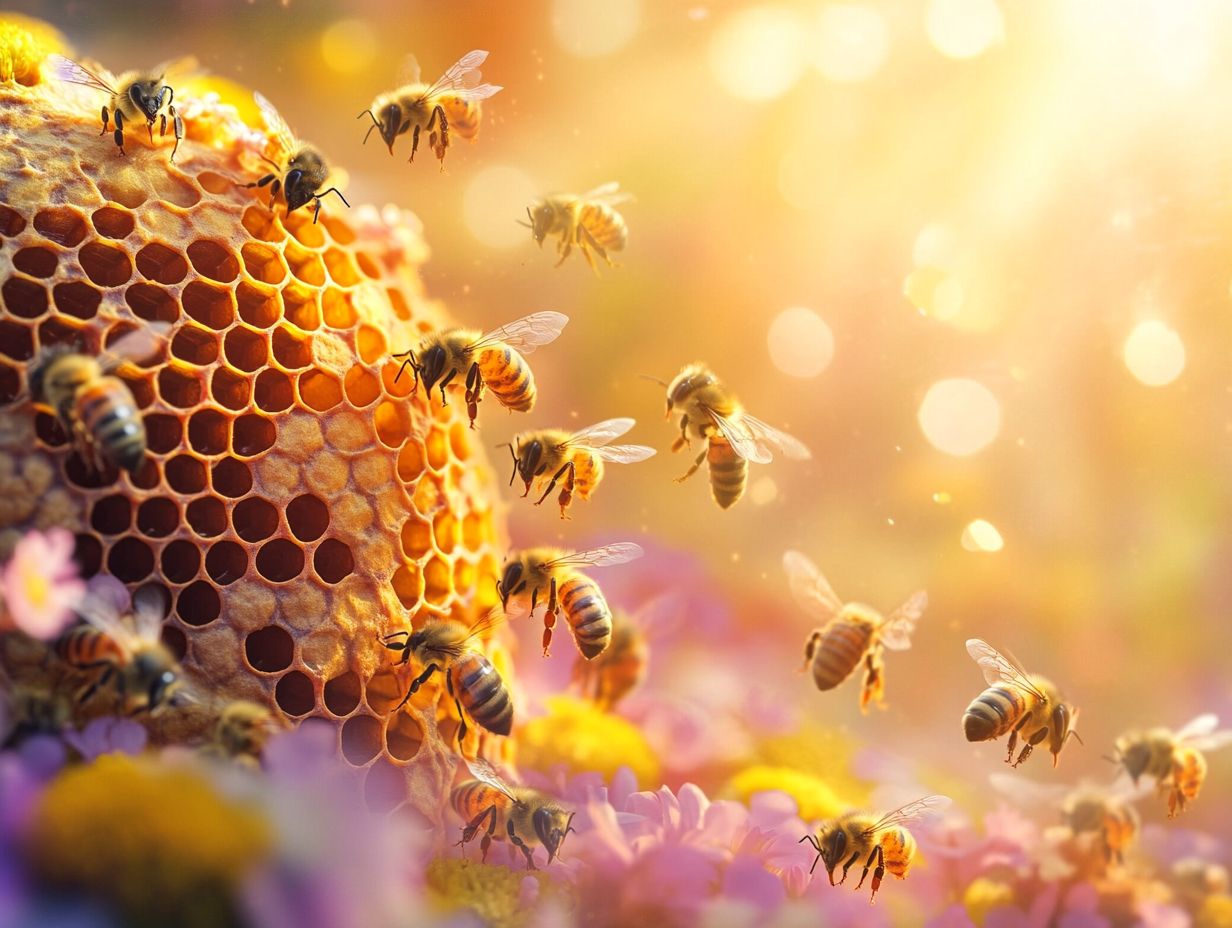
Reviewing and analyzing data from hive records grants you invaluable insights into your colony management practices. This enables you to make informed decisions for your future beekeeping activities.
By meticulously tracking various factors like bee population dynamics, honey production rates, and the occurrence of diseases or pests, you can identify specific areas that may need enhancement. Recognizing patterns in your data allows you to evaluate the effectiveness of your methods for controlling pests that might harm the bees over time.
Stay proactive and adjust your approach based on these insights. For instance, if a particular method consistently fails to deliver the desired results, you have the opportunity to pivot your approach. You should also track details like mite counts and chalk brood incidents to provide deeper insights.
Adjusting your hive management practices based on these insights ensures that your colonies remain healthy and productive. This ultimately leads to a more sustainable beekeeping operation. Paying close attention to aspects like queen health and swarm prevention strategies can also contribute to long-term success.
Check out this video for tips on effective hive management!
Frequently Asked Questions
What are beehive records and why are they important?
Beehive records are detailed logs or documentation of the activities and events that occur within a beehive. They are important because they provide valuable information about the health and productivity of the hive, which is essential for beekeepers to manage their hives effectively.
What types of information are typically included in beehive records?
Beehive records can contain a variety of information, such as the date and location of the hive, the number and health of the bees, the amount of honey and pollen stored, and any changes or problems observed in the hive.
How can beehive records help beekeepers maintain healthy hives?
By regularly recording and monitoring hive activity, beekeepers can identify potential issues or changes in the hive that may require attention. This allows them to take proactive measures to maintain the health and productivity of their hives. Keeping good records also helps in tracking hive characteristics and honey production.
Start keeping your own beehive records today, and take the first step towards effective hive management!
Are there any specific methods or tools used to keep beehive records?
Beekeepers use various methods to keep beehive records. These include log sheets, spreadsheets, mobile apps, and specialized software like Hive Tracks and BeeBase.
Can beehive records also be used for research purposes?
Beehive records are a treasure trove for researchers! They reveal insights about honeybee health and behavior.
By studying hive records, researchers can gain insights into the factors that affect hive health and inform strategies for improving honeybee populations. Data on brood development, honey production, and colony health are particularly useful.
What are some potential consequences of not keeping beehive records?
Not keeping beehive records can lead to critical issues. Beekeepers need this information to keep their hives healthy and productive!
Without records, beekeepers may struggle to identify problems, which can harm hive health and productivity. Missing details like the availability of flowers that bees collect nectar from, queen bee health, and mite counts can significantly hinder effective colony management.

